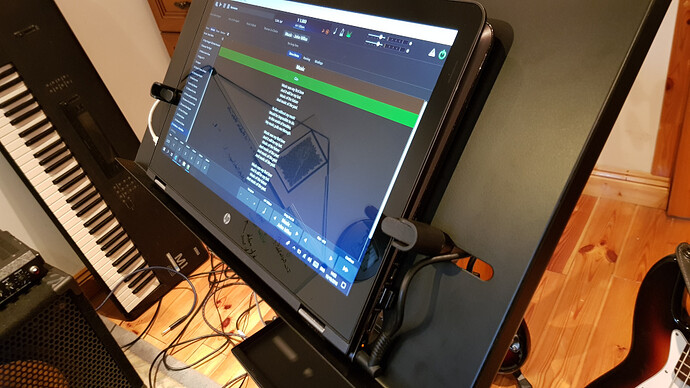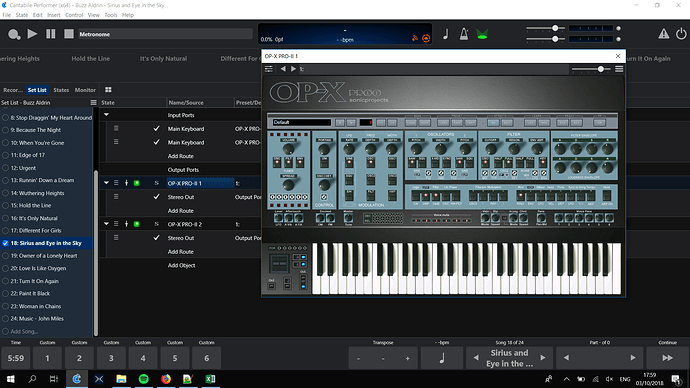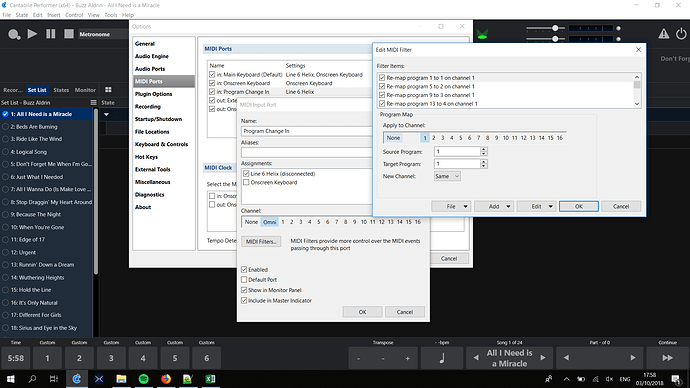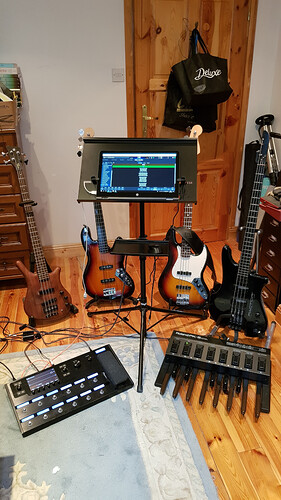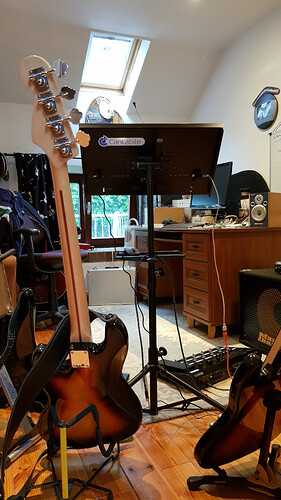Intro.
I thought you might be interested to see how I’m using Cantabile at the heart of my on-stage rig.
I’m perhaps unusual amongst Cantabile users, in that I’m not a keyboard player; I’m a bass player who also plays MIDI bass pedals, and Cantabile is the great enabler in all of this.
Here’s a diagram of my stage rig.
You’ll see from the diagram that I use a Line 6 Helix as my effects unit, but the Helix is much more than that; it is also the master switching unit for the entire rig. When I select a Patch on the Helix, the appropriate song is selected on Cantabile, via the magic of MIDI Program Change. Here’s how:
The Background.
I used the ‘Setlist’ feature within the Helix to model my band’s setlist. Each Helix Setlist comprises a series of Presets, and each Preset has four Patches. I use one Preset per song, meaning I have up to four different Patches available to me per song. Most songs use only a single Patch but some have more Patches; to add boost, switch on an octaver, etc.
When you select a Patch within a Setlist on the Helix, by default the Helix sends a MIDI Program Change message corresponding to the position of the Patch within the Setlist. This was perfect for my requirements - but there was a slight wrinkle which I’ll explain shortly, and will show how Cantabile’s features helped me to overcome it.
Cantabile.
Once I had programmed my setlist into the Helix, I then needed to program it into Cantabile.
I run Cantabile onstage on an HP Envy x360 Convertible laptop, which folds right back on itself so it appears like a large tablet. This is mounted on a sturdy laptop stand, next to my vocal microphone.
I use Cantabile to show lyrics, song key reminders, reminders to swap basses, etc., for each song. For songs that need the MIDI bass pedals, Cantabile acts as the VST plugin for my OP-X Pro-II synths and Structure 2 samplers.
I created a Cantabile setlist, and added the relevant songs to the setlist. I added lyrics, key information, reminder notes and VST plugins to each song. At this stage, at least notionally, the setlists had the same shape and form on the Helix and on Cantabile. Now it was time to get the Helix and Cantabile talking via MIDI.
Getting Cantabile to react to Helix MIDI Program Change messages.
The Helix performs many functions in this setup. In addition to being the effects unit and amp simulator for the bass guitars, it is connected, via USB, to the laptop and acts as the laptop’s audio interface. Digital audio data passes from VST plugins on the laptop to the Helix thence out to the monitors and Front-of-House, and MIDI data passes from the Helix to the laptop.
Once I had this connection in place, it looked like I was all set: Whenever I selected a patch on the Helix, it sent the corresponding MIDI Program Change message to Cantabile, and I could see these messages arriving on Cantabile’s MIDI monitors. However, because of the Helix’s Setlist / Preset / Patch arrangement, there was not a one-to-one relationship between songs on the Helix and songs on Cantabile. Bear in mind that I was using one Preset per song on the Helix - not one Patch per song. In the MIDI world on the Helix, Patch 1 of Preset 1 sends MIDI Program Change 1, Patch 2 of Preset 1 sends MIDI Program Change 2, etc. It was clear I needed some way of mapping the Patches on the Helix to Songs on Cantabile, according to the following table:
Preset 1, Patch 1 → Song 1
Preset 1, Patch 2 → Song 1
Preset 1, Patch 3 → Song 1
Preset 1, Patch 4 → Song 1
Preset 2, Patch 1 → Song 2
Preset 2, Patch 2 → Song 2
Preset 2, Patch 3 → Song 2
Preset 2, Patch 4 → Song 2
…
Preset n, Patch 1 → Song n
Preset n, Patch 2 → Song n
Preset n, Patch 3 → Song n
Preset n, Patch 4 → Song n
That was when I discovered Cantabile’s MIDI Filters; particularly the Program Map filter. I used them like this:
I added a MIDI Input port on Cantabile, and called it “Program Change In.” On the Program Change In input port, I added a series of Program Map filters that did the mapping I needed as per the table above. And that was it!
The last piece of the puzzle was integrating the bass pedals. I connected the MIDI Out port on the PK-5A pedals to the MIDI In port on the Helix, made sure my MIDI channel mappings were correct, set whichever octave transposition values I wanted for the one-octave bass pedals on the MIDI Route Settings and away I went. It just worked.
Now when I select a Patch within a Preset on the Helix, I get my Song lyrics, text notes and synth / sampler VST settings set up on Cantabile too; all from a single stomp of my left foot.


